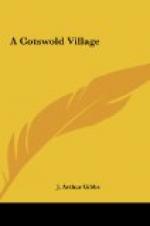In spite of complaints of east winds and night frosts, May is the nicest month in the year take it all in all. In London this is the case even more than in the country. The trees in the parks have then the real vivid green foliage of the country. There is a freshness about everything in London which only lasts through May. By June the smoke and dirt are beginning to spoil the tender, fresh greenery of the young leaves. In the early morning of May 12th, 1897, more than an inch of snow fell in the Cotswolds, but it was all gone by eight o’clock. In spite of the weather, May is “the brightest, merriest month of all the glad New Year.” Everything is at its best. Man cannot be morose and ill-tempered in May. The “happy hills and pleasing shade” must needs “a momentary bliss bestow” on the saddest of us all. Look at yonder thoroughbred colt grazing peacefully in the paddock: if you had turned him out a month ago he would have galloped and fretted himself to death; but now that the grass is sweet and health-giving, he is content to nibble the young shoots all day long. What a lovely, satin-like coat he has, now that his winter garments are put off! There is a picture of health and symmetry! He has just reached the interesting age of four years, is dark chestnut in colour, and sixteen hands two and a half inches in height; grazing out there, he does not look anything like that size. Well-bred horses always look so much smaller than they really are, especially if they are of good shape and well proportioned. Alas! how few of them, even thoroughbreds, have the real make and shape necessary to carry weight across country, or to win races! You do not see many horses in a lifetime in whose shape the critical eye cannot detect a fault. We know the good points as well as the bad of this colt, for we have had him two years. Deep, sloping shoulders are his speciality; and they cover a multitude of sins. Legs of iron, with large, broad knees; plenty of flat bone below the knee, and pasterns neither too long nor too upright. Well ribbed up, he is at the same time rather “ragged-hipped,” indicative of strength and weight-carrying power. How broad are his gaskins! how “well let down” he is! What great hocks he has! But, alas I as you view him from behind, you cannot help noticing that his hindlegs incline a little outwards, even as a cow’s do—they are not absolutely straight, as they should be. Then as to his golden, un-docked tail: he carries it well—a fact which adds twenty pounds to his value; but, strange to say, it is not “well set on,” as a thoroughbred’s ought to be. He does not show the quality he ought in his hindquarters. Still his head, neck and crest are good, though his eye is not a large one. How much is he worth—twenty, fifty, a hundred, or two hundred pounds? Who can tell? Will he be a charger, a fourteen-stone hunter, or a London carriage horse? All depends how he takes to jumping. His height is against him,—sixteen hands two and a half inches is at least two inches too big for a hunter. Nevertheless, there are always the brilliant exceptions. Let us hope he will be the trump card in the pack.




